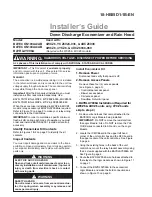
23
Manifold valve
Pressure
gauge
Lo
Hi
Outdoor unit
Service
valve
Wide tube
Narrow
tube
Indoor unit
Vacuum pump
CAUTION
NOTE
To prevent nitrogen from enter
the refrigerant system in the
liquid state, the top of the
cylinder must be higher than
the bottom when you pres-
surize the system. Usually,
the cylinder is used in a
vertical standing position.
(Refer to the previous page.)
(4)
Do a leak test of all joints of the tubing (both
indoor and outdoor) and both wide and narrow
service valves. Bubbles indicate a leak. Wipe off
the soap with a clean cloth after the leak test.
(5)
After the system is found to be free of leaks,
relieve the nitrogen pressure by loosening the
charge hose connector at the nitrogen cylinder.
When the system pressure is reduced to normal,
disconnect the hose from the cylinder.
Evacuation
(1)
Attach the charge hose end described in the
preceding steps to the vacuum pump to evacuate
the tubing and indoor unit.
Confirm that the “Lo” knob of the manifold valve
is open. Then, run the vacuum pump. The
operation time for evacuation varies with the
tubing length and capacity of the pump. The
following table shows the amount of time for
evacuation:
The required time in the above table is calculated
based on the assumption that the ideal (or target)
vacuum condition is around 10 mmHg abs.
(2)
When the desired vacuum is reached, close the
“Lo” knob of the manifold valve and turn off the
vacuum pump.
If tubing length is
less than 50 ft.
45 minutes or more
If tubing length is
longer than 50 ft.
90 minutes or more
Required time for evacuation
when 30 gal/h vacuum pump is used
Vacuum pump
Cap
Narrow tube
Wide tube
Manifold valve
Vacuum
gauge
Lo
Hi
Fig. 48
Fig. 49
02-291AirCon Final 12/11/02 2:46 PM Page 23









































